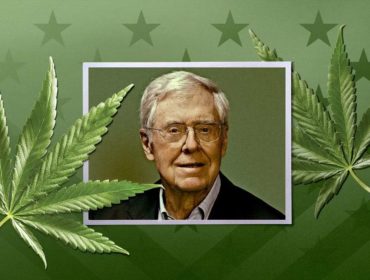It’s the world’s most commonly cultivated, trafficked, and used drug; as the push for legalization at home and abroad grows, marijuana is garnering significant attention from investors, manufacturers, and researchers. Despite the plant being illegal under federal law as a Schedule I drug, the U.S. legal marijuana industry was estimated at $13.6 billion in 2019 with 340,000 jobs devoted to the handling of plants, according to New Frontier Data.
A total of 35 states and the District of Columbia have legalized marijuana for medical use, 16 of which allow adults to legally use the substance for recreational use as of April 2021. And that number may continue to rise, as more people are accepting the idea of legalizing marijuana across the United States.
Changing Attitudes Toward Pot
Remember “Reefer Madness”—the film from the 1930s that was produced to teach parents and their children about the threat of marijuana? The film was originally intended to educate audiences but has now become a cult classic and a piece of satire.
Just like the attitude about the film has changed, so are people’s feelings about marijuana itself. This is especially true as we learn more about the drug and the apparent benefits that come with using it for medical purposes. Once considered an illicit substance, it is still deemed a controlled drug under federal government guidelines. But the stigma is being shed at a breathtaking speed, and it appears marijuana is on its way to the mainstream.
According to a Pew Research survey, 67% of Americans believe the use of marijuana should be legalized. This is double what it was in 2000—31%—and five times what it was in 1969—12%. A New York University study revealed the percentage of adults aged 50 to 64 reporting marijuana use has doubled in the past decade to 9% and use among adults 65 and older has increased seven times during the same period to nearly 3%. The U.S. marijuana industry will generate $85 billion in sales in 2030, according to Cowen analyst Vivien Aze
Marijuana Laws By State
Policy Reform
As Democrats have control of both the House and the Senate as well as the presidency, marijuana policy reform advocates are hopeful legislative change could occur on the federal level soon. Politico pointed out that, in 2019, 296 members of Congress (68%) represent the 33 states with at least medical marijuana, which means there are sufficient votes to pass long-awaited bills. There are already several bills in the new Congress pertaining to marijuana.
Marijuana companies raised $116.8 billion in 2019, according to cannabis industry research firm Viridian Capital Advisors. We can expect this trend to continue, but important to the U.S. industry is also banking reform. Big banks are currently afraid of money laundering charges they may face if they work with these businesses. Besides the difficulty of getting capital, this means tremendous risks and inconvenience for companies operating in cash. The American Bankers’ Association has been pushing for more legal clarity and bridging the gap between federal and state law, and we could see banks warm up to cannabis if bills like the SAFE Banking Act are passed.
Former U.S. Attorney General William Barr announced he will not go after marijuana companies operating in states where the plant is legal. He also said the current discrepancy between state and federal law is “untenable” and needs to be fixed. He supports a federal law that prohibits marijuana everywhere.
President Joe Biden has expressed that he wants marijuana decriminalized as well as having the criminal records of those convicted of possession of the drug expunged. Meanwhile, Vice President Kamala Harris was one of the co-sponsors of a bill called the Marijuana Justice Act introduced by Senator Cory Booker, which decriminalizes marijuana. Harris has expressed support of expunging convictions for those caught with marijuana and calls out for a path toward decriminalization and legalization.
CBD
Marijuana has been used as a means of treating illnesses in different cultures for thousands of years. The federal law banning it in the U.S., the Marihuana Tax Act, was passed in 1937. There is now growing acceptance of the plant as a legitimate option for patients who suffer from medical problems like chronic pain or seizures in modern-day America.
This is mostly thanks to cannabidiol or CBD—a natural compound found in cannabis plants that is non-psychoactive. This means it doesn’t make the consumer high. CBD is sold as an ingredient in oils, oral sprays, creams, pills, or edibles like gummies and lollipops. Purveyors claim CBD can provide relief from pain, combat anxiety, and depression. It’s even been linked to helping people living with cancer.
It’s true CBD is having its moment. The term “CBD gummies” was the third-most searched food-related term on Google in the U.S. in 2018. Large companies like Corona owner Constellation Brands (STZ.B) and Marlboro cigarette maker Altria Group (MO) have bought multibillion-dollar stakes in marijuana companies. But forecasts for the CBD market argue this isn’t just a temporary wellness craze.
New Frontier Data estimates the market for CBD derived from hemp will grow from a $390 million-dollar market in 2018 to a $1.3 billion market—or 3.3x—by 2022. Brightfield Group says the hemp CBD market can reach as much as $22 billion by 2022. Defending its lofty prediction, Brightfield’s managing director Bethany Gomez said, “We are a team of highly conservative analysts and we did not take this lightly – I honestly believe that these are conservative numbers. We have no rose-colored glasses in terms of the bizarre and challenging regulatory framework that surrounds this industry, it will always be two steps forward, one step back. There are sure to be some problematic regulations and bumps along the way. But there is too much momentum, too much demand, and too much potential for this industry not to explode.”
The FDA and CBD: Softening Stance?
Under the current U.S. Food and Drug Administration’s (FDA) rules, all drugs containing CBD, a Schedule I substance, require the agency’s approval. In June 2018, the agency also approved a CBD, marijuana-derived drug for the first time. GW Pharmaceuticals’ (GWPH) Epidiolex was placed in the least restrictive Schedule V of the Controlled Substances Act by the U.S. Drug Enforcement Administration (DEA), which means it has a low potential for abuse.
Under federal rules, it is also illegal to market food products or dietary supplements that contain CBD, but the FDA indicated that may change in the future. In a December 2018 press release, it said, “Although such products are generally prohibited to be introduced in interstate commerce, the FDA has the authority to issue a regulation allowing the use of a pharmaceutical ingredient in a food or dietary supplement. We are taking new steps to evaluate whether we should pursue such a process.” The statement was published after the Farm Bill legalizing the regulated production of hemp, another source of CBD was passed.
This is great news for many companies betting on the compound and dealing with its murky legal status. But can investors expect all CBD to be placed in Schedule V or unscheduled altogether soon? Not quite. It’s not easy for CBD to be unscheduled altogether because of international treaties the U.S. has signed. And while Epidiolex qualifies for Schedule V, only other FDA-approved marijuana-derived drugs with low levels of THC can expect to join it there.
Big Marijuana
Since the explosion of marijuana products is almost certain, experts are now wondering what the industry might look like. Will large corporations come to dominate it and flood the market with a cheap and generic product? Ryan Stoa, a professor of law at Concordia University and the author of Craft Weed: Family Farming and the Future of the Marijuana Industry told The Verge this will be difficult because of the variety of strains available. Another factor he discussed was the consumer base’s interest in locally-made or locally-produced artisanal products.
“On the regulator size, states have a role to play,” he said. “You already see states like California putting a cap or limit on the size of marijuana farms, essentially saying, ‘If we’re going to legalize this industry, we want to spread the benefits to as many people as possible.’ Other states are capable of replicating that model.
Technology is also shaping the industry. Weed delivery company Eaze has raised $37 million and is reportedly valued at $300 million. It recently announced it is creating a platform to ship CBD products to 41 states.16 On-demand marijuana and cannabis delivery service Dutchie raised $3 million in 2018 from the venture capital firms of rapper Snoop Dogg and basketball player Kevin Durant among others.
Expect to hear words like machine learning, automation, and blockchain used in relation to marijuana more often as well. MTrac promises to solve the industry’s banking problems. Bloom Automation is building robots to trim and process cannabis.
Source: https://www.investopedia.com/articles/investing/111015/future-marijuana-industry-america.asp












